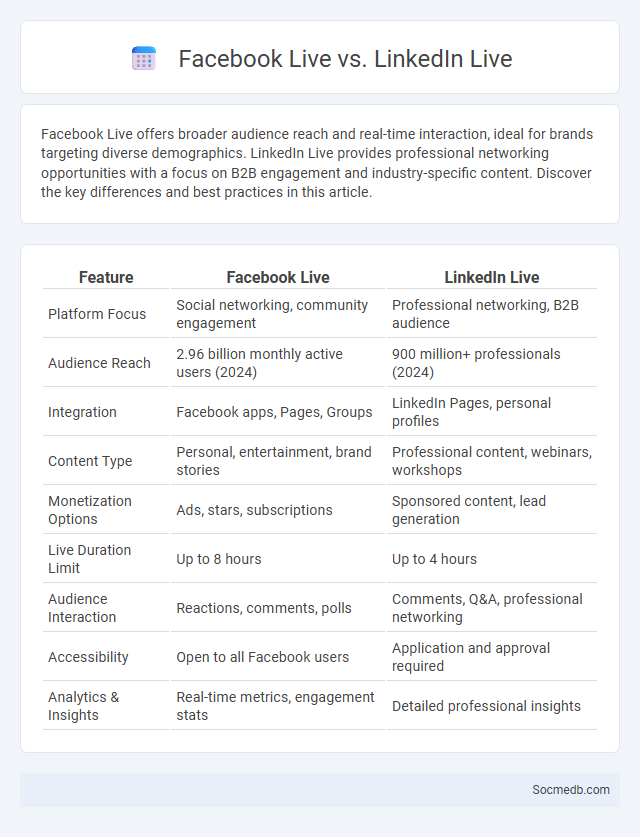
Photo illustration: Facebook Live vs LinkedIn Live
Facebook Live offers broader audience reach and real-time interaction, ideal for brands targeting diverse demographics. LinkedIn Live provides professional networking opportunities with a focus on B2B engagement and industry-specific content. Discover the key differences and best practices in this article.
Table of Comparison
| Feature | Facebook Live | LinkedIn Live |
|---|---|---|
| Platform Focus | Social networking, community engagement | Professional networking, B2B audience |
| Audience Reach | 2.96 billion monthly active users (2024) | 900 million+ professionals (2024) |
| Integration | Facebook apps, Pages, Groups | LinkedIn Pages, personal profiles |
| Content Type | Personal, entertainment, brand stories | Professional content, webinars, workshops |
| Monetization Options | Ads, stars, subscriptions | Sponsored content, lead generation |
| Live Duration Limit | Up to 8 hours | Up to 4 hours |
| Audience Interaction | Reactions, comments, polls | Comments, Q&A, professional networking |
| Accessibility | Open to all Facebook users | Application and approval required |
| Analytics & Insights | Real-time metrics, engagement stats | Detailed professional insights |
Introduction to Live Streaming Platforms
Live streaming platforms enable real-time broadcasting of video content to a global audience via social media, enhancing user engagement and interaction. Popular platforms such as Twitch, YouTube Live, and Facebook Live offer tools for instant communication, audience analytics, and monetization options. These platforms have revolutionized digital marketing, entertainment, and community building by providing authentic and immediate connections between content creators and viewers.
Overview of Facebook Live
Facebook Live enables real-time video broadcasting to engage your audience directly on Facebook's platform, enhancing interaction through live comments and reactions. This feature supports high-quality streaming with options for screen sharing, guest invites, and video archiving for extended reach. Marketers and content creators can leverage Facebook Live to increase visibility, foster community engagement, and drive authentic connections with followers.
Overview of LinkedIn Live
LinkedIn Live is a powerful social media feature designed for real-time video broadcasting to professional audiences, enabling businesses and individuals to engage authentically with their network. It supports interactive elements like comments and reactions, fostering dynamic communication and deeper connections. Leveraging LinkedIn Live can significantly enhance brand visibility, thought leadership, and community building within industry-specific networks.
Key Features Comparison
Social media platforms offer diverse key features including real-time messaging, content sharing, and audience engagement analytics tailored to different user needs. Your choice should consider factors like multimedia support, privacy settings, and algorithmic content curation that affect reach and interaction. Advanced targeting tools and integrated advertising options enhance brand visibility and user experience across platforms like Facebook, Instagram, Twitter, and LinkedIn.
Audience Demographics and Reach
Understanding social media audience demographics is crucial for tailoring content to specific age groups, locations, and interests, increasing engagement and conversions. Platforms like Facebook, Instagram, LinkedIn, and TikTok each attract unique user bases, allowing you to target your campaigns precisely based on gender, income level, and user behavior. Optimizing your social media strategy by leveraging these demographic insights expands your reach and maximizes your content's impact.
Engagement and Interaction Tools
Social media platforms offer a variety of engagement and interaction tools such as likes, comments, shares, polls, and live streaming features that boost user participation and foster community growth. These tools enable You to connect directly with your audience, gather feedback, and increase content visibility through algorithmic favor. Optimizing the use of these features enhances brand loyalty and drives meaningful conversations on platforms like Facebook, Instagram, and Twitter.
Content Types and Use Cases
Social media platforms support diverse content types including images, videos, live streams, articles, stories, and polls, each designed to engage specific audience segments. Brands leverage visual content like Instagram photos and TikTok videos to boost brand awareness, while LinkedIn articles and webinars position businesses as industry thought leaders. User-generated content, influencer collaborations, and real-time engagement through comments and direct messages enhance community building and customer loyalty across platforms.
Monetization and Business Opportunities
Social media platforms offer extensive monetization opportunities through advertising, affiliate marketing, sponsored content, and product sales, enabling businesses to reach target audiences effectively. Leveraging analytics and targeted campaigns allows you to maximize ROI and enhance customer engagement. Building a strong online presence on platforms like Instagram, Facebook, TikTok, and LinkedIn drives brand awareness and creates scalable revenue streams.
Pros and Cons of Each Platform
Facebook offers robust community-building tools and extensive advertising options, making it ideal for businesses seeking broad audience engagement; however, concerns about data privacy and algorithm-driven content can limit authentic user interaction. Instagram excels in visual storytelling and influencer marketing, providing strong brand visibility, but its emphasis on aesthetics may lead to unrealistic expectations and engagement pressure. Twitter facilitates real-time communication and trending topic participation, enhancing brand responsiveness, yet the platform's fast pace can result in misinformation and limited content longevity, impacting Your social media strategy effectiveness.
Choosing the Best Live Streaming Platform for Your Needs
Selecting the best live streaming platform involves evaluating factors such as audience size, engagement tools, and monetization options. Platforms like Twitch excel in gaming communities, while YouTube Live offers broad reach and robust analytics for various content types. Consider platform compatibility with your devices and integration with social media channels to maximize visibility and interaction.
 socmedb.com
socmedb.com